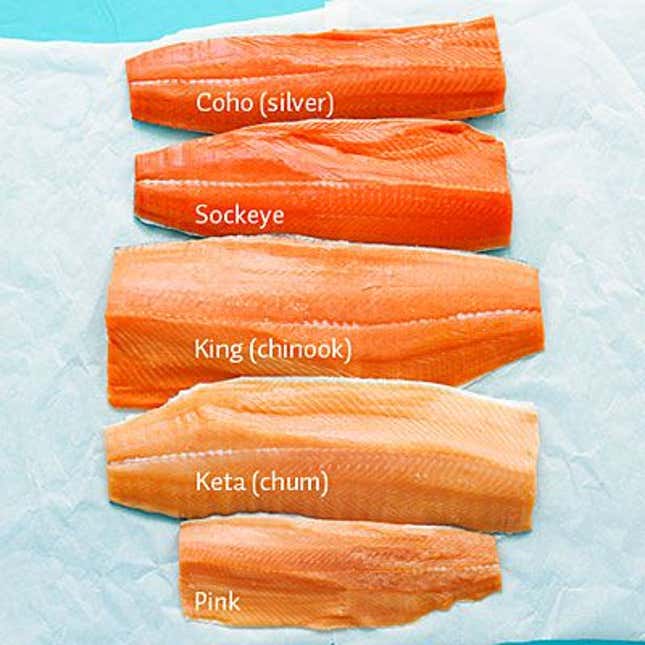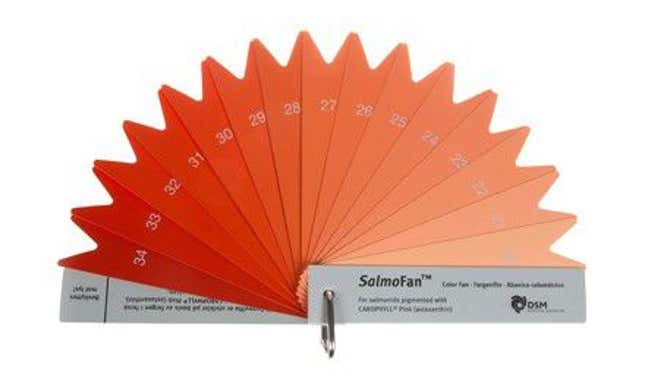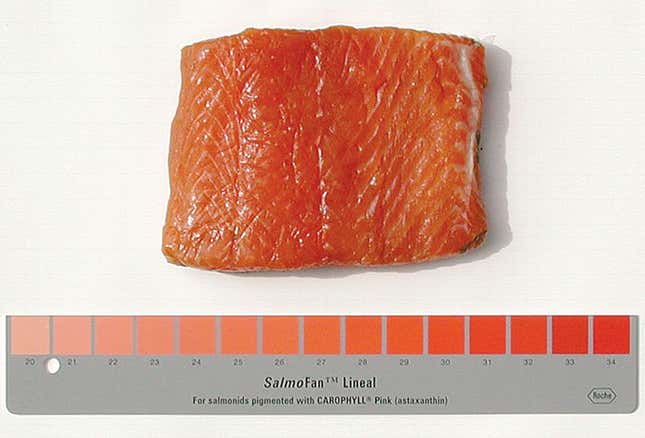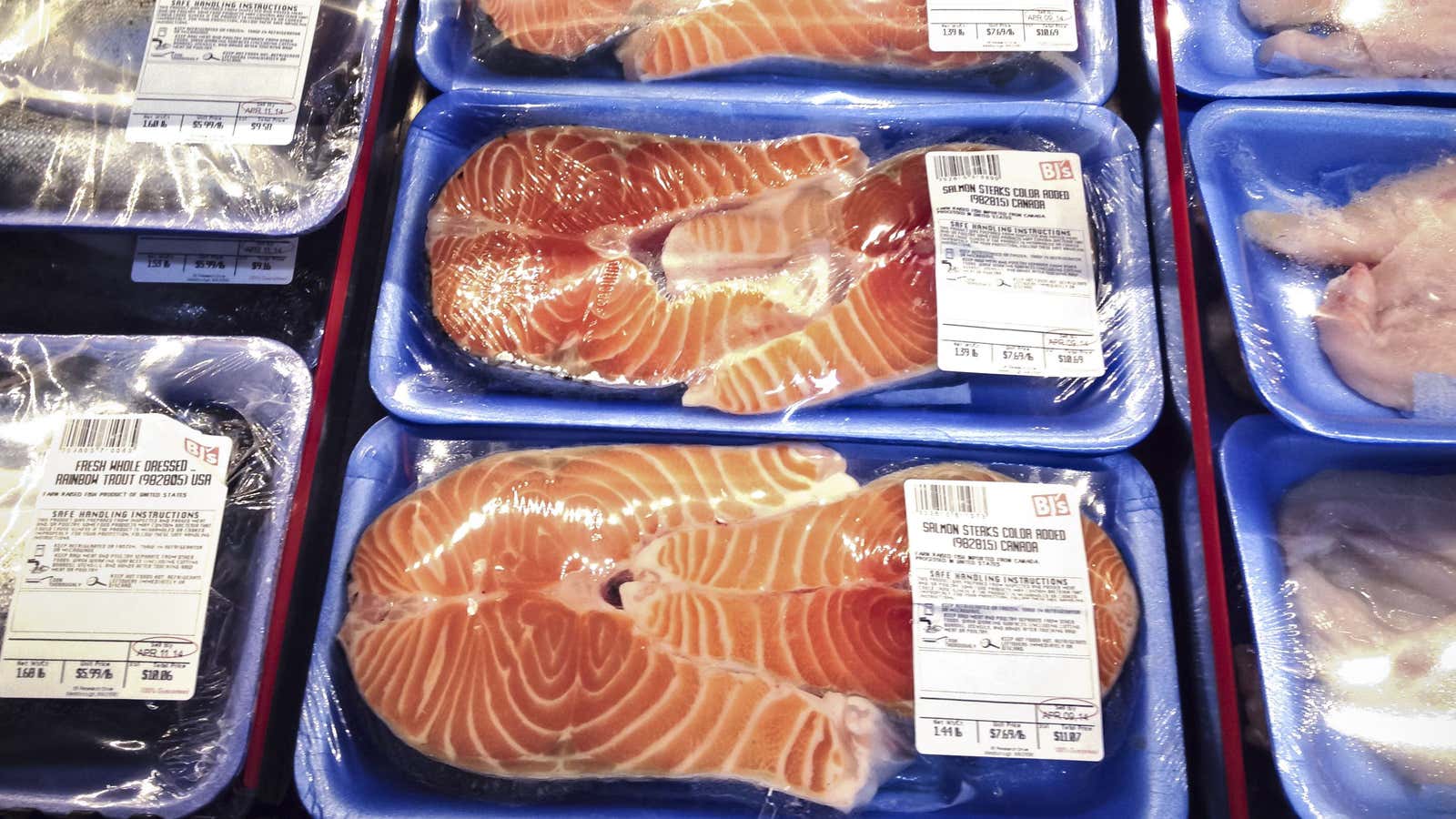So distinctive is salmon’s orangey-pink hue that Crayola named a crayon after it. It’s an accurate representation of the flesh of wild salmon, but not that of farmed salmon, whose meat is naturally gray. Or at least, it would be if salmon farmers didn’t spike their artificial diet with pink-ifying pellets.
Wild salmon get their ruddy shade by eating krill and shrimp, which contain a reddish-orange compound called astaxanthin. (That shrimp-heavy diet is also what turns flamingos pink.) The spectrum varies with the species: Since Alaska’s sockeye salmon are closer to the Bering Sea’s teeming krill, they’re the reddest of all. Salmon further south—Coho, king, and pink, for instance—eat relatively less krill and shrimp, giving them a lighter orange hue.

Like their wild cousins, farmed salmon come in a spectrum of pinks and oranges, depending on diet. But it’s the farmers—and not the food chain—that determine the salmon’s color.
Since farm-raised salmon live in a pen, they’re fed kibble made from a hodge-podge that might include oil and flesh of smaller fish (e.g. herring and anchovies), corn gluten, ground-up feathers, soybeans, chicken fat, genetically engineered yeast.

An essential ingredient in these pellets is astaxanthin. Sometimes it’s made “naturally” through algae or pulverized crustaceans; other manufacturers synthesize the compound in a lab, using petrochemicals. While it provides the salmon with some of the vitamins and antioxidants they’d get in the wild, salmon health isn’t the selling point.
It’s the “pigmenting,” to use feed industry parlance, that really matters, letting salmon farmers determine how red their fillets will be. (Thanks to a 2003 lawsuit, they have to alert customers to the fact of “added” coloring.)
To facilitate that selection process, pharmaceutical giant Hoffman-LaRoche developed what’s now known as DSM SalmoFan™ (Dutch multinational DSM acquired it in 2002).

Wild salmon—which is tastier, more nutritious and can cost two to three times that of farmed salmon (which is usually $6-10 per pound)—serves as the aesthetic standard as well.
Research by DSM, now one of the biggest astaxanthin makers, shows wealthy shoppers go for darker-hued salmon, which fetch up to $1 per pound more than lighter shades—something other industry research (pdf) suggests as well. One study found farmed salmon colored lower than 23 on SalmoFan (see below) to be ”difficult to sell at any price” (pdf).

Pigmenting supplements are the most expensive component of the farmed salmon diet, constituting up to 20% of feed costs. But it boosts profitability. And while creating a product that fetches prices approaching those of wild-caught salmon, farmers can still churn out fillets at an industrial clip. That often makes things harder on the Pacific Northwest fishermen whose catch they’re trying to emulate. An abundance of farmed salmon forces fishermen to lower prices of their wild-caught salmon in order to compete (pdf, p.xxiii).
The fact that consumers will shell out more for salmon that looks wild—even if it got that way by eating pellets in its pen—hints that people want to be eating wild salmon, but not quite badly enough to buy the real deal. If it’s price that’s keeping consumers from buying wild-caught salmon, they might want to consider saving a few bucks more and start demanding farmers cut out those expensive pigments—and sell them salmon that’s gray.
